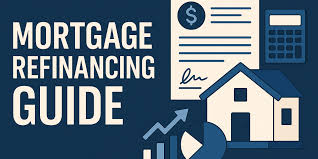Refinancing your mortgage can be one of the smartest financial decisions you’ll ever make. With interest rates shifting constantly, understanding refinance mortgage rates is essential for homeowners who want to lower monthly payments, shorten loan terms, or tap into their home’s equity.
In this 2025 guide, we’ll break down everything you need to know about mortgage refinancing, the factors that influence rates, how to get the best deal, and whether refinancing makes sense for you.
What Does Refinancing a Mortgage Mean?
Refinancing means replacing your current mortgage with a new loan, usually at a different interest rate and term. Homeowners typically refinance to:
- Lower monthly payments by getting a lower interest rate.
- Pay off loans faster by switching to a shorter term.
- Tap into home equity for big expenses like renovations or debt consolidation.
- Switch loan types, such as moving from an adjustable-rate mortgage (ARM) to a fixed-rate mortgage.
Why Refinance in 2025?
In 2025, refinance mortgage rates remain attractive for many borrowers. While rates vary depending on the economy and lender policies, refinancing can still:
✅ Save thousands of dollars over the life of the loan.
✅ Provide cash through equity to cover major expenses.
✅ Offer financial flexibility in uncertain economic conditions.
Current Refinance Mortgage Rates in 2025
- 30-Year Fixed Refinance Rate: Around 6.5% – 7.0% (depending on credit score & lender).
- 15-Year Fixed Refinance Rate: Around 5.7% – 6.2%.
- Adjustable-Rate Mortgages (ARMs): Initial rates can be lower (5% – 6%) but may rise later.
(Note: These figures are estimates and vary by lender, location, and borrower profile.)
Factors That Affect Refinance Mortgage Rates
Several elements determine the rate you’ll be offered:
- Credit Score – Higher scores get the best rates.
- Loan-to-Value Ratio (LTV) – The more equity you have, the better the rate.
- Debt-to-Income Ratio (DTI) – Lenders want to see manageable debt.
- Loan Amount – Jumbo loans may carry higher rates.
- Economic Conditions – Inflation, Federal Reserve policies, and housing demand all impact rates.
Types of Mortgage Refinancing
1. Rate-and-Term Refinance
- Goal: Lower your interest rate or change your loan term.
- Best for: Homeowners who want lower monthly payments.
2. Cash-Out Refinance
- Goal: Borrow more than your current balance and take the difference as cash.
- Best for: Renovations, education, or consolidating high-interest debt.
3. Cash-In Refinance
- Goal: Pay down some of your mortgage balance to reduce LTV.
- Best for: Borrowers seeking a lower rate without increasing debt.
4. Streamline Refinance
- Goal: Faster process with less paperwork.
- Best for: FHA, VA, or USDA loan holders.
Pros and Cons of Refinancing
✅ Pros
- Lower interest rates → save money long term.
- Reduce monthly payments.
- Access cash through home equity.
- Switch from variable to fixed rates.
❌ Cons
- Closing costs (2% – 5% of loan amount).
- Extending your loan term could mean paying more interest overall.
- Not ideal if you plan to move soon.
How to Get the Best Refinance Mortgage Rates in 2025
- Improve Your Credit Score – Pay down debt, correct errors, and avoid late payments.
- Shop Around – Compare at least 3–5 lenders before deciding.
- Consider Loan Terms – Shorter terms usually come with lower rates.
- Negotiate Closing Costs – Some lenders may offer discounts.
- Lock in Your Rate – Rates can change daily, so lock when favorable.
Should You Refinance in 2025?
Refinancing makes sense if:
- Your current mortgage rate is at least 1% higher than current rates.
- You plan to stay in your home long enough to break even on closing costs.
- You need cash for large expenses but want lower interest compared to credit cards or personal loans.
It might not be worth it if:
- You plan to sell your home soon.
- Closing costs outweigh long-term savings.
- You’re close to paying off your current mortgage.
FAQs – Refinance Mortgage Rates 2025
Q1: How often can I refinance my mortgage?
A: There’s no legal limit, but lenders may require a waiting period (usually 6–12 months).
Q2: Are refinance rates higher than purchase mortgage rates?
A: Sometimes, but not always. It depends on your financial profile and lender.
Q3: How much does it cost to refinance?
A: Typically 2% – 5% of the loan amount in closing costs.
Q4: Can refinancing hurt my credit score?
A: A small, temporary drop may occur due to credit inquiries, but responsible management can improve your score in the long run.
Q5: Is refinancing worth it in 2025?
A: Yes—if you secure a lower rate, plan to stay in your home, and save enough to offset closing costs.
Conclusion
Refinance mortgage rates in 2025 offer homeowners an opportunity to cut costs, restructure debt, and achieve greater financial freedom. By understanding the different refinancing options, comparing lenders, and considering long-term goals, you can make the most of your home’s equity and reduce your financial burden.
If you’re considering refinancing this year, start by checking your credit, exploring lender options, and calculating whether the savings outweigh the costs. Done right, refinancing could save you thousands and set you up for a stronger financial future.
